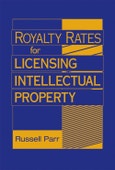Table of Contents
About the Author.Acknowledgments.
Preface.
Chapter 1: Intellectual Property and Corporate Value.
Patents.
Patent Trends.
Who Owns the Most Patents?
Technology Classifications.
History of U.S. Patent Applications.
Trademarks.
Copyrights.
Trade Secrets.
Evaluating Trade Secrets.
Chapter 2: Licensing Intellectual Property.
Forces Behind Licensing.
Licensing Motivation.
Reasons Companies Engage in Licensing.
Chapter 3: Use of the Twenty–Five Percent Rule in Valuing IP.
Introduction.
History of the Rule.
Explanation of the Rule.
Illustration of the Rule.
Application of the Rule.
Justification for the Rule.
Criticisms of the Rule.
Empirical Test of the Rule.
Royalty Rates.
Industry Profits.
Licensee Profits.
Royalty Rates and Licensee Profits.
Successful Licensee Profits.
Royalty Rates and Successful Licensee Profits.
Conclusions.
Chapter 4: Royalty Rate Guidelines.
Royalty Rates for Technology, Third Edition.
Royalty Rates for Trademarks and Copyrights, Third Edition.
Royalty Rates for Pharmaceuticals and Biotechnology, Sixth Edition.
Chapter 5: Comparable Licenses.
Internal Licenses Are Often Self–Serving.
Relevant Time Period.
Financial Condition of Both Licensing Parties.
Relevant Industry Transactions.
International Transactions.
Non–Monetary Compensation.
Exclusivity.
Package Licenses.
Comparative Analysis Summarized.
Chapter 6: Technology Royalty Statistics.
Automotive.
Battery Terminals.
Transaxles.
Manufacturing Technology.
Self–Dimmable Rearview Mirrors.
Chemicals.
Flame–Retardant Products.
Fuel Reactor Technology.
Fuel Technology.
Communications Equipment and Services.
Third–Generation Wireless Technology.
Video Patent Pool.
Code Division Multiple Access Technology.
Wideband Code Division Multiple Access Technology.
Computer Hardware.
Macintosh Enhancement.
Computer Architecture.
PS/2 Computers.
Modem Standards.
Modems.
Computer Software.
Apple Operating System.
Decision and Data Mining.
Windows OS Code.
Construction.
Paving.
Polyvinyl Chloride Pipe Products.
Electronics.
DVD/Video Players.
Detection Monitoring.
Flat Panel Display Technology.
Remote Metering.
Food and Beverage.
Mineral Water.
Packaging.
Eggs.
Medical Equipment.
Breast Cancer Detection.
Cancer Screening.
Catheter.
Digital Scanner.
Laser Finger–Perforator Technology.
Laser Hair–Removal.
Pharmaceuticals and Biotechnology.
Semiconductors.
High–Bandwidth Chip Connection Technology.
Lightning Resistance.
Manufacturing.
Pentium II Processor.
Power Conversion.
Thin Film Ferroelectric Technology.
SIMMs.
Waste Management.
Recycling of Asphalt Roofing Debris.
Used Oil Recovery.
Tire Recycling.
Chapter 7: Trademark and Copyright Royalty Statistics.
Apparel.
Everlast.
Lotto.
Disney.
Ralph Lauren and Polo.
Artwork.
Textile Patterns.
Andretti.
Big League Chew.
Dannon/Yocream.
Condiment Names.
Personal Care.
Hawaiian Tropic.
Tapazole.
Vidal Sassoon.
Publishing.
Restaurants.
Ruth s Chris Steakhouse.
Capital Grille Steakhouse.
Benihana Japanese Restaurants.
Chapter 8: Profit Differentials and Royalty Rates.
Business Enterprise Framework.
Beyond Commodity Earnings.
Driving Forces Behind Royalty Rates.
Infringement Damages Analysis.
The Analytical Approach.
Hypothetical Example.
General Profit Margins.
Generic Pricing.
Chapter 9: Investment Rates of Return and Royalty Rates.
Basic Principles.
Investment Rate of Return Royalty Rates.
Royalty Rates.
Appropriate Return on Monetary Assets.
Appropriate Return on Tangible Assets.
Appropriate Return on Intangible Assets and Intellectual Property.
Royalty Rate for the Specific Patented Invention.
Benefits of Investment Rate of Return Analysis.
Chapter 10: Discounted Cash Flow Analysis and Royalty Rates.
Generic and Mature Commodity Corporate Value.
New Pharmaprod Corporation Royalty Rate.
Risk–Adjusted Net Present Value.
Success Rates.
Success Rate Adjusted DCF Example.
Valuation Using the Relief–from–Royalty Method.
Inputs for the Relief–from–Royalty Method.
Remaining Life of the Patent Protection.
Forecast Revenue.
Royalty Rate.
Tax Rate.
Discount Rate.
Present Value Calculation.
Chapter 11: Court–Awarded Royalty Rates.
Top Ten.
Frequency of Rates Awarded.
Industry Categorizations.
Considerations Cited by the Courts in Determining a Reasonable Royalty.
Existing Licenses.
Importance of Expert Testimony.
Use of Projections.
Entire Market Value Rule.
Federal Circuit Decisions on Royalty Rates.
Conclusion.
Chapter 12: Litigation Rates Are Higher.
Comparison of Litigated and Non–Litigated Licenses.
Chapter 13: Royalty Rate Services.
RoyaltySource.
RoyaltyStat.
Intellectual Property Research Associates (IPRA).
Securities and Exchange Commission EDGAR Archives.
Chapter 14: Monitoring License Agreements and Financial Compliance.
Introduction.
Breaking Through Old Perceptions.
What Is a Royalty Audit?
Red Flags.
Auditor Selection.
How Is the Royalty Audit Done?
Desk Audits.
Drafting a License Agreement to Lower the Likelihood of Mistakes.
Common Errors.
Communications Between Licensor and Licensee.
Conclusion: Benefits of a Sound Monitoring Program.
Notes.
Index.








